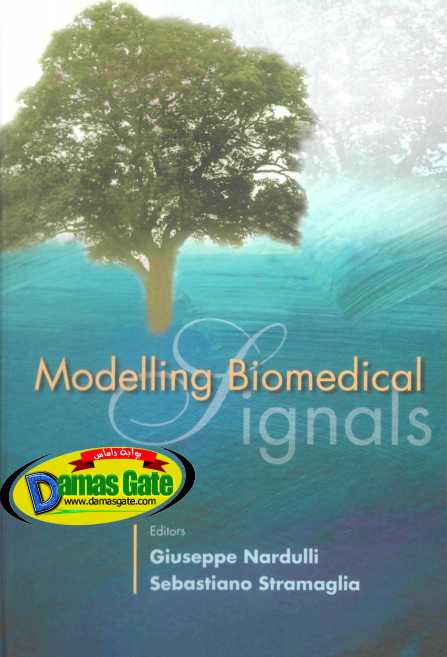Modelling Biomedical Signals

Preface
In the last few years, concepts and methodologies initially developed in theoretical physics have found high applicability in a number of very different areas. This book, a result of cross-disciplinary interaction among physicists, biologists and physicians, covers several topics where methods and approaches rooted in physics are successfully applied to analyze and to model biomedical data. The volume contains the papers presented at the International Workshop Modelling Bio-medical Signals held at the Physics Department of the University of Bari, Italy, on September 19-21th 2001. The workshop was gathered under the auspices of the Center of Innovative Technologies for Signal Detection and Processing of the University of Bari (TIRES Centre); the Organizing Committee of the Workshop comprised L. Angelini, R. Bellotti, A. Federici, R. Giuliani. G. Gonnella, G.Nardulli and S. Stramaglia. The workshop opened on September 19th 2001 with two colloquia given by profs. N. Accornero (University of Rome, la Sapienza), on Neural Networks and Neurosciences, and E. Marinari (University of Rome, la Sapienza) on Physics and Biology. Around 70 scientists attended the workshop, coming from different fields and disciplines. The large spectrum of competences gathered in the workshop favored an intense and fruitful exchange of scientific information and ideas. The topics discussed in the workshop include: decision support systems in medical science; several analyses of physiological rhythms and synchronization phenomena; biological neural networks; theoretical aspects of artificial neural networks and their role in neural sciences and in the analysis of EEG and Magnetic Resonance Imaging; gene expression patterns; the immune system; protein folding and protein crystallography.
For the organization of the workshop and the publication of the present volume we acknowledge financial support from the Italian Ministry of University and Scientific Research (MURST) under the project (PRIN) "Theoretical Physics pf Fundamental Interactions", from the TIRES Centre, the Physics Department of the University of Bari and from the Section of Bari of the Istituto Nazionale di Fisica Nucleare (INFN). We also thank the Secretary of the Workshop, Mrs. Fausta Cannillo and Mrs. Rosa Bitetti for their help in organizing the event.
Giuseppe Nardulli Sebastiano Stramaglia
University of Bari
Book cover Modelling Biomedical Signals
Modelling Biomedical Signals
Giuseppe Nardulli, Sebastiano Stramaglia
Concepts and methodologies initially developed in physics have been finding high applicability in many different areas. This work, a result of cross-disciplinary interaction among physicists, biologists and physicians, covers several topics where methods and approaches rooted in physics are successfully applied to analyze and to model biomedical data. Included are papers on physiological rhythms and synchronization phenomena, gene expression patterns, the immune system, decision support systems in medical science, protein folding and protein crystallography. The volume can be used as a reference for graduate students and researchers at the interface of physics, biology and medicine.
Download
http://s18.alxa.net/s18/srvs2/02/003...al.Signals.rar

Preface
In the last few years, concepts and methodologies initially developed in theoretical physics have found high applicability in a number of very different areas. This book, a result of cross-disciplinary interaction among physicists, biologists and physicians, covers several topics where methods and approaches rooted in physics are successfully applied to analyze and to model biomedical data. The volume contains the papers presented at the International Workshop Modelling Bio-medical Signals held at the Physics Department of the University of Bari, Italy, on September 19-21th 2001. The workshop was gathered under the auspices of the Center of Innovative Technologies for Signal Detection and Processing of the University of Bari (TIRES Centre); the Organizing Committee of the Workshop comprised L. Angelini, R. Bellotti, A. Federici, R. Giuliani. G. Gonnella, G.Nardulli and S. Stramaglia. The workshop opened on September 19th 2001 with two colloquia given by profs. N. Accornero (University of Rome, la Sapienza), on Neural Networks and Neurosciences, and E. Marinari (University of Rome, la Sapienza) on Physics and Biology. Around 70 scientists attended the workshop, coming from different fields and disciplines. The large spectrum of competences gathered in the workshop favored an intense and fruitful exchange of scientific information and ideas. The topics discussed in the workshop include: decision support systems in medical science; several analyses of physiological rhythms and synchronization phenomena; biological neural networks; theoretical aspects of artificial neural networks and their role in neural sciences and in the analysis of EEG and Magnetic Resonance Imaging; gene expression patterns; the immune system; protein folding and protein crystallography.
For the organization of the workshop and the publication of the present volume we acknowledge financial support from the Italian Ministry of University and Scientific Research (MURST) under the project (PRIN) "Theoretical Physics pf Fundamental Interactions", from the TIRES Centre, the Physics Department of the University of Bari and from the Section of Bari of the Istituto Nazionale di Fisica Nucleare (INFN). We also thank the Secretary of the Workshop, Mrs. Fausta Cannillo and Mrs. Rosa Bitetti for their help in organizing the event.
Giuseppe Nardulli Sebastiano Stramaglia
University of Bari
Book cover Modelling Biomedical Signals
Modelling Biomedical Signals
Giuseppe Nardulli, Sebastiano Stramaglia
Concepts and methodologies initially developed in physics have been finding high applicability in many different areas. This work, a result of cross-disciplinary interaction among physicists, biologists and physicians, covers several topics where methods and approaches rooted in physics are successfully applied to analyze and to model biomedical data. Included are papers on physiological rhythms and synchronization phenomena, gene expression patterns, the immune system, decision support systems in medical science, protein folding and protein crystallography. The volume can be used as a reference for graduate students and researchers at the interface of physics, biology and medicine.
Download
http://s18.alxa.net/s18/srvs2/02/003...al.Signals.rar